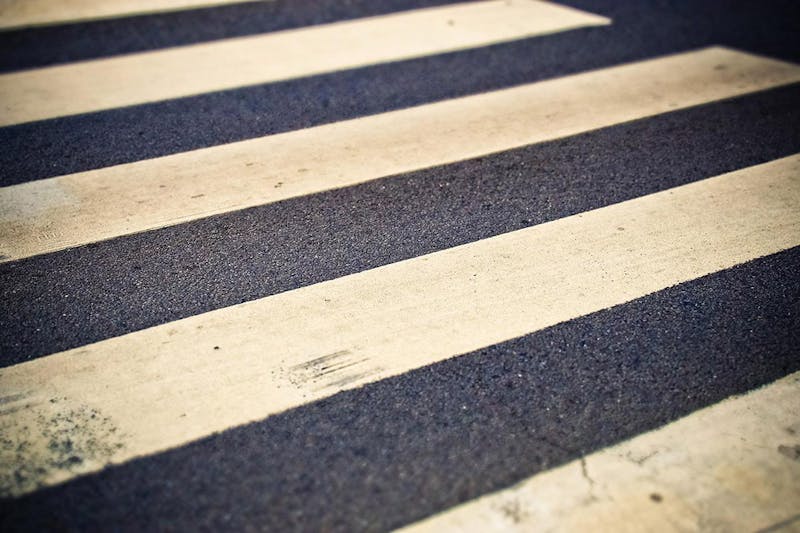
All pedestrians in Arkansas have the right to crosswalks that allow them to safely cross the road without unreasonable delays. However, if you’ve spent any time at all as a pedestrian, you’ll have noticed that not all crosswalks are created equally.
Design plays an important role in how safe a given crosswalk is. At McMath Woods P.A., we know that pedestrians are safest in crosswalks that utilize raised crosswalks, rapid flashing beacons, or other enhanced designs. Here are our top picks for the safest types of crosswalks.
Raised Crosswalks
Mid-block crosswalks are typically located on low-speed, low-volume roads, often in neighborhoods. Solid white lines should denote where the crosswalk is as well as the path of travel. While this provides a visual clue to both pedestrians and drivers, many drivers fail to account for the presence of pedestrians and do not slow down as they approach.
Authors of a Federal Highway Administration (FHWA) study found that raised crosswalks force drivers to slow down and reduce pedestrian accidents by 45%. Also referred to as speed humps, raised crosswalks force drivers to slow down to about 20 mph. At 20 mph, the fatality rate for pedestrians in pedestrian-vehicle collisions is only 5%, compared to a 45% fatality rate when the vehicle is traveling at 30 mph.
It does not take much height to force drivers to slow down, either. The average raised crosswalk is elevated to only about three or three and a half inches, with a width of approximately ten feet. The cost of installing a raised crosswalk averages out to $8,170, a small cost to save human lives.
Crosswalks With Rapid Flashing Beacons
At crosswalks equipped with rapid flashing beacons, pedestrians press a button to engage lights that flash on pedestrian crossing signs. The flashing lights then warn drivers that a pedestrian is either going to be crossing the street or is already in the crosswalk.
Data shows that rapid flashing beacons are effective at protecting pedestrians. The FHWA found that when installed and used correctly, rapid flashing beacon crossings see 47% fewer pedestrian crashes. They also improve the rate of driver yielding, as they are designed to look different than standard flashing beacons with:
- Different shapes
- Brighter lights
- Faster flashing rate
Rapid flashing beacons are not sufficient on their own and should always be used in conjunction with other designs. White indicator lines and rectangular yellow pedestrian crossing signs should always accompany these lights.
Experts also caution against the overuse of rapid flashing beacons. Rather than being widely implemented, they would work most effectively in areas with existing significant pedestrian safety problems. Widespread use would likely diminish their overall effectiveness.
Signs in Crosswalks
Although it may seem like an overly simple solution, rectangular yellow signs that read “State Law Stop for Pedestrian Within Crosswalk” are a surprisingly effective tool for protecting pedestrians. These signs are placed in the center yellow line of the road, either directly in front of or within the crosswalk itself.
Placing pedestrian crossing signs in the road rather than off to the side draws driver attention better and is associated with improved speed reductions and yielding. The signs are also exceptionally affordable compared to other pedestrian safety designs, making it an economical choice for cities, towns, or neighborhoods that still need time to designate funds for more significant interventions.
HAWK Beacons
High-intensity activated crosswalk (HAWK) beacons are highly effective at reducing the number of pedestrian injuries, fatalities, and accidents. When a pedestrian reaches a crosswalk with HAWK beacons, they will press a button that engages traffic lights above the road, similar to those found at major intersections. The key difference here is that there is only a red light.
The red light will initially flash to signal that drivers should slow down and stop and then turn solid red, allowing the pedestrian to pass safely. No cars are allowed to pass through the sidewalk when the light remains solid red. After a designated period of time, the red light will resume flashing, allowing drivers to pass through the crosswalk with caution so long as it is clear. The light will then turn off, and traffic will resume as normal.
HAWK beacons are an excellent example of how city designers can incorporate pedestrians. These types of crosswalks are especially effective on higher-speed roads with multiple lanes of traffic, particularly where there is a lot of foot traffic.
Unfortunately, the cost of implementing HAWK beacons is significantly higher than other designs, such as mid-crosswalk signs and rapid flashing beacons. This barrier may make it difficult for areas experiencing a significant number of pedestrian accidents and fatalities to actually implement these safety standards.
Raised Yellow Tactile Bumps
The raised yellow bumps you’ll find at crosswalks are not for decoration. Sometimes referred to as Braille paving, these bumps provide a tactile cue to visually impaired pedestrians. They signal:
- That a crosswalk is present
- The direction in which you should cross
Patterns will vary depending on what a visually impaired person is approaching. A crosswalk will feature raised bumps in an even line, but there are also:
- Offset dots for train tracks or high ledges
- Oval dots for street trolley, tram, or street-level transportation tracks
- Stripes for tripping hazards, like stairs
The bright yellow color also serves as a visual difference for pedestrians who are not completely blind and can still perceive shifts in color.
Enhancements for Crosswalk Visibility
Even small changes can make a big difference in terms of pedestrian safety. Enhancing crosswalk visibility by doing some of the following is often effective at reducing the number of pedestrian accidents:
- Increase lighting
- Use reflective pedestrian crossing signs
- Repaint white crossing lines when dull
- Trim back bushes or trees that block a pedestrian’s or driver’s view of the road
- Place signs up to 50 feet ahead of crossings
Surviving a Pedestrian Accident
Even if you always use the safest types of crosswalks and only cross when it is safe to do so, you could still be hit by a car.
More than 6,700 pedestrians were killed in auto collisions in 2020. While you might count yourself lucky to have survived a pedestrian accident, your journey is far from over. You will still need to deal with your physical injuries and related medical bills, not to mention any income you might be missing out on while you focus on your recovery.
McMath Woods P.A. is here for you. Our lawyers believe that every accident victim deserves help and support as they move forward in life. That’s why we work so hard to prove fault and correctly value your claim, and we never let the insurance company push our clients to accept anything less than what they deserve.
Contact us to schedule your confidential consultation to discuss your accident with a pedestrian accident attorney.

